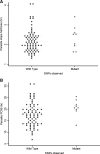Polymorphisms in the K13-propeller gene in artemisinin-susceptible Plasmodium falciparum parasites from Bougoula-Hameau and Bandiagara, Mali
- PMID: 25918205
- PMCID: PMC4458826
- DOI: 10.4269/ajtmh.14-0605
Polymorphisms in the K13-propeller gene in artemisinin-susceptible Plasmodium falciparum parasites from Bougoula-Hameau and Bandiagara, Mali
Abstract
Artemisinin-resistant Plasmodium falciparum malaria has been documented in southeast Asia and may already be spreading in that region. Molecular markers are important tools for monitoring the spread of antimalarial drug resistance. Recently, single-nucleotide polymorphisms (SNPs) in the PF3D7_1343700 kelch propeller (K13-propeller) domain were shown to be associated with artemisinin resistance in vivo and in vitro. The prevalence and role of K13-propeller mutations are poorly known in sub-Saharan Africa. K13-propeller mutations were genotyped by direct sequencing of nested polymerase chain reaction (PCR) amplicons from dried blood spots of pre-treatment falciparum malaria infections collected before and after the use of artemisinin-based combination therapy (ACT) as first-line therapy in Mali. Although K13-propeller mutations previously associated with delayed parasite clearance in Cambodia were not identified, 26 K13-propeller mutations were identified in both recent samples and pre-ACT infections. Parasite clearance time was comparable between infections with non-synonymous K13-propeller mutations and infections with the reference allele. These findings suggest that K13-propeller mutations are present in artemisinin-sensitive parasites and that they preceded the wide use of ACTs in Mali.
© The American Society of Tropical Medicine and Hygiene.
Figures



References
-
- Djimde AA, Fofana B, Sagara I, Sidibe B, Toure S, Dembele D, Dama S, Ouologuem D, Dicko A, Doumbo OK. Efficacy, safety, and selection of molecular markers of drug resistance by two ACTs in Mali. Am J Trop Med Hyg. 2008;78:455–461. - PubMed
-
- Mita T, Tanabe K. Evolution of Plasmodium falciparum drug resistance: implications for the development and containment of artemisinin resistance. Jpn J Infect Dis. 2012;65:465–475. - PubMed
-
- Ariey F, Witkowski B, Amaratunga C, Beghain J, Langlois AC, Khim N, Kim S, Duru V, Bouchier C, Ma L, Lim P, Leang R, Duong S, Sreng S, Suon S, Chuor CM, Bout DM, Ménard S, Rogers WO, Genton B, Fandeur T, Miotto O, Ringwald P, Le Bras J, Berry A, Barale JC, Fairhurst RM, Benoit-Vical F, Mercereau-Puijalon O, Ménard D. A molecular marker of artemisinin-resistant Plasmodium falciparum malaria. Nature. 2014;505:50–55. - PMC - PubMed
-
- Hall N, Pain A, Berriman M, Churcher C, Harris B, Harris D, Mungall K, Bowman S, Atkin R, Baker S, Barron A, Brooks K, Buckee CO, Burrows C, Cherevach I, Chillingworth C, Chillingworth T, Christodoulou Z, Clark L, Clark R, Corton C, Cronin A, Davies R, Davis P, Dear P, Dearden F, Doggett J, Feltwell T, Goble A, Goodhead I, Gwilliam R, Hamlin N, Hance Z, Harper D, Hauser H, Hornsby T, Holroyd S, Horrocks P, Humphray S, Jagels K, James KD, Johnson D, Kerhornou A, Knights A, Konfortov B, Kyes S, Larke N, Lawson D, Lennard N, Line A, Maddison M, McLean J, Mooney P, Moule S, Murphy L, Oliver K, Ormond D, Price C, Quail MA, Rabbinowitsch E, Rajandream MA, Rutter S, Rutherford KM, Sanders M, Simmonds M, Seeger K, Sharp S, Smith R, Squares R, Squares S, Stevens K, Taylor K, Tivey A, Unwin L, Whitehead S, Woodward J, Sulston JE, Craig A, Newbold C, Barrell BG. Sequence of Plasmodium falciparum chromosomes 1, 3–9 and 13. Nature. 2002;419:527–531. - PubMed
Publication types
MeSH terms
Substances
Associated data
- Actions
- Actions
- Actions
- Actions
- Actions
- Actions
- Actions
- Actions
- Actions
- Actions
- Actions
- Actions
- Actions
- Actions
- Actions
- Actions
- Actions
- Actions
- Actions
- Actions
- Actions
- Actions
- Actions
- Actions
- Actions
- Actions
- Actions
- Actions
- Actions
- Actions
- Actions
- Actions
- Actions
- Actions
- Actions
- Actions
- Actions
- Actions
- Actions
- Actions
- Actions
- Actions
- Actions
- Actions
- Actions
- Actions
- Actions
- Actions
- Actions
- Actions
- Actions
- Actions
- Actions
- Actions
- Actions
- Actions
- Actions
- Actions
- Actions
- Actions
- Actions
- Actions
- Actions
- Actions
- Actions
- Actions
- Actions
- Actions
- Actions
- Actions
- Actions
- Actions
- Actions
- Actions
- Actions
- Actions
- Actions
- Actions
- Actions
- Actions
- Actions
- Actions
- Actions
- Actions
- Actions
- Actions
- Actions
- Actions
- Actions
- Actions
- Actions
- Actions
- Actions
- Actions
- Actions
- Actions
- Actions
- Actions
- Actions
- Actions
- Actions
- Actions
- Actions
- Actions
- Actions
- Actions
- Actions
- Actions
- Actions
- Actions
- Actions
- Actions
- Actions
- Actions
- Actions
- Actions
- Actions
- Actions
- Actions
- Actions
- Actions
- Actions
- Actions
- Actions
- Actions
- Actions
- Actions
- Actions
- Actions
- Actions
- Actions
- Actions
- Actions
- Actions
- Actions
- Actions
- Actions
- Actions
- Actions
- Actions
- Actions
- Actions
- Actions
- Actions
- Actions
- Actions
- Actions
- Actions
- Actions
- Actions
- Actions
- Actions
- Actions
- Actions
- Actions
- Actions
- Actions
- Actions
- Actions
- Actions
- Actions
- Actions
- Actions
- Actions
- Actions
- Actions
- Actions
- Actions
- Actions
- Actions
- Actions
- Actions
- Actions
- Actions
- Actions
- Actions
- Actions
- Actions
- Actions
- Actions
- Actions
- Actions
- Actions
- Actions
- Actions
- Actions
- Actions
- Actions
- Actions
- Actions
- Actions
- Actions
- Actions
- Actions
- Actions
- Actions
- Actions
- Actions
- Actions
- Actions
- Actions
- Actions
- Actions
- Actions
- Actions
- Actions
- Actions
- Actions
- Actions
Grants and funding
LinkOut - more resources
Full Text Sources
Other Literature Sources
Research Materials

